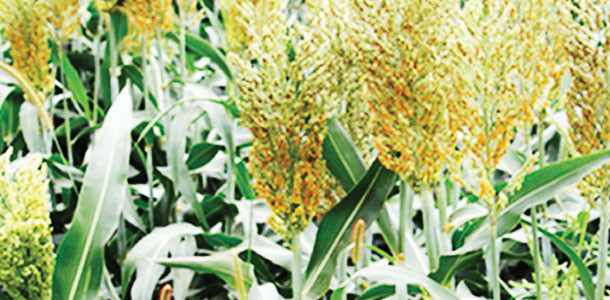With the advent of BMR hybrids, forages like forage sorghum, sorghum-sudan and sudan hybrids have moved sorghums from the “just heifer” feed category to the top of the “dairy” quality feed category (and became even better heifer feed). In the sorghum family, there are three types of BMR plants available: BMR Gene 6, BMR Gene 12 and BMR Gene 18. For purposes of this article, BMR Gene 6 will be generally referenced.
With the decreased lignin and increased digestibility, BMR sorghum now competes with corn silage in many geographical locations in both yield (assuming a double crop) and energy. In warmer climates, such as the lower half of the U.S., sorghums compete with corn silage head to head.
In the cooler upper Midwest and the New England states, the combination of the summer crop of sorghum and a winter crop like triticale provides very competitive dry matter yields to straight corn silage.
These yields come with several added benefits. The first is that the composite of the triticale and BMR sorghums will produce similar energy to corn silage with more protein. A second benefit would be the value of using a cover crop. This includes having roots growing in your soil virtually year-round, improvements in organic matter and soil structure plus much more.
Other advantages of a sorghum rotation include their ability to produce a ton of dry matter silage with about half the rain or irrigation as corn and their ability to thrive in hot weather. In the upper Midwest and New England, this can also be a downfall because if the summers are cool and wet, sorghums will underperform.
When feeding sorghums for the first time, you will notice a very high palatability due to the five-carbon and six-carbon sugar levels. Cows will love it and prefer it to almost any other forage.
Sorghum-sudans and sudan hybrids, which are cut several times during the growing season and usually are not allowed to produce a seed head, will have from 12 to 18 percent crude protein (CP) depending on fertility and relative maturity.
Of the two, sudan hybrids will be higher in CP than sorghum-sudans. Forage sorghums can be 8 to 11 percent CP, 15 percent starch and 5 to 10 percent sugar (and should be harvested as the first kernels reach soft-dough stage). These protein levels become significant when you consider that BMR sorghums are equal or higher in energy than corn silage with the extra protein.
The nutritional side of sorghums requires some understanding as the plants will test high for neutral-detergent fiber (50 to 65 percent). A nutritionist who looks at a typical sorghum feed test will usually be put off by these neutral-detergent fiber (NDF) levels. The main problem is that the energy value will appear to be very low. There are at least two culprits.
First is the high NDF value, and second is the fact that, as of yet, forage testing labs have small numbers of sorghum samples and an even smaller number of BMR samples. The result is that near-infrared spectroscopy values for digestible neutral-detergent fiber (NDFd) are suspect (read “low”). This makes for a lower-than-accurate appraisal of the real energy value for the BMR silage or hay.

What is the solution? Advanced Agricultural Systems researcher Tom Kilcer and Rick Grant of the Miner Institute, both of whom have done considerable research on BMR sorghums, say that the real energy value of BMR sorghum products can be arrived at by adding 0.12 to 0.15 units to the net energy for lactation (NEL) as calculated on the feed test because of the consistently good NDFd.
This would mean that the calculated value, say 0.64 NEL, would be adjusted to the range of 0.76 to 0.79 NEL. These adjusted energy levels would now make the proper ration.
So now the question becomes: Should the addition be 0.12 or 0.15, or somewhere in between? The solution is found by looking at the acid-detergent fiber (ADF). ADF is directly related to maturity at cutting. If the ADF is anywhere from 28 to 35, the proper NEL addition is 0.15. If the ADF is higher, use 0.12. Obviously, after a few trials, your nutritionist will gain confidence in these adjustments.
We are looking forward to a time when feed testing labs will have invested enough effort to gain more accurate numbers for sorghum energy and establish the difference between older non-BMR types and the BMR hybrids. Until that time, the aforementioned adjustment methods will get you very close to the proper diet.
Our wish for accurate sorghum assays will probably not happen until labs unify their methods for such things as sugar, NDFd, in haylage and corn silage plus starch availability in corn silage so that testing results will be comparable from one lab to another. Obviously, it surely won’t happen until sorghums become as popular on dairies as they deserve to be given their yield and feeding characteristics.
The last caveat for sorghums is their chance to contain either nitrate or prussic acid. In regards to nitrate, fertilizer needs for sorghums are from 1 to 1¼ pounds of N per growing day. This means for sorghum sudans and sudan hybrids, the first harvest is in 45 days, and any subsequent harvest is in 30 days.
These crops should be fertilized accordingly. The first application can be manure (which will not all be available for the first cut); however, it is better to use urea or ammonium sulfate for the subsequent applications using best guess for how much N will be left from the manure.
For the forage sorghums, the same rate of N will be needed (1 to 1¼ pounds per growing day), but now you must calculate for the growing season, which is from 85 to 110 days, depending on the relative maturity that you choose. Following these recommendations for N will almost certainly remove any danger of NO3.
The only warning is to watch when harvesting sorghum shortly after a drought has broken. The exciting thing for the upper Midwest is that now there are BMR forage sorghums as short as 85 days.
Prussic acid is formed in any sorghum plant after a freeze. Harvesting the sorghum and allowing it to ferment (10 days) will dissipate all of the prussic acid. If you are grazing, a more careful process should be followed.
If the frost was a complete killing frost, allowing the cows back into the sorghum pasture after seven to 10 days will be safe. If it was a light frost, more prussic acid will be formed at the next frost until the plant is no longer growing.
It is obviously wise to avoid night grazing during potential frost events. However, prussic acid poisoning is very rare since the causative factors have become very well understood. There is very little danger of prussic acid poisoning when feeding silage if the silage has been allowed to ferment for six to eight weeks before feeding.
BMR sorghums have a place on most farms and really do bear some investigation if you have never used them before. Using them in rotation allows farmers to spread risk among different crops and the possibility of increasing yield per acre over planting corn silage. For the highest forage quality, use only BMR hybrids. PD
PHOTO
Sorghum near Kearney, Nebraska. Photo by PD staff.
Larry Hawkins
Manager
Byron Seed








